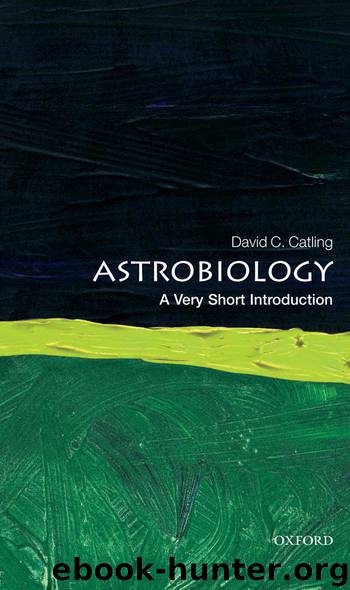Astrobiology: A Very Short Introduction (Very Short Introductions) by David C. Catling

Author:David C. Catling [Catling, David C.]
Language: eng
Format: azw3, mobi
Publisher: Oxford University Press
Published: 2013-09-27T04:00:00+00:00
An inside view of terrestrial life: the cell
We have just considered biology on a global scale but under the microscope all organisms are composed of cells of different types that put them into one of three domains, the Eukarya, Archaea, or Bacteria. The last two are microbial and are sometimes lumped together as prokaryotes, although many microbiologists now consider this term antiquated because archaea and bacteria are biochemically dissimilar. DNA floats freely in the middle of the archaeal and bacterial cells, whereas in eukaryotes the DNA is housed inside a membrane-bound nucleus. Archaea and bacteria are single cells, with the exception of some bacterial species that join up in a row to form filaments. Eukaryotes can be single celled, such as an amoeba or a baker’s yeast, but only eukaryotes form large, three-dimensional multicellular organisms, such as mushrooms or humans.
The classification into three domains of life was motivated by genetics and supersedes an older ‘five kingdom’ system of plants, animals, fungi, protists (single-celled eukaryotes), and bacteria. However, these old terms are still used in taxonomy, which classifies an organism below its domain according to Kingdom, Phylum, Class, Order, Family, Genus, and Species. The mnemonic I use to remember these levels (or taxa) is far too rude to mention but another is ‘Keeping Precious Creatures Organized For Grumpy Scientists’. The taxonomic levels of a human, for example, are the animal kingdom, chordate phylum, mammal class, primate order, hominid family, Homo genus, and sapiens species. The Swedish botanist Carolus Linnaeus (1707–78), who gave us the word biology, developed modern taxonomy, including binomial names for organisms, e.g. Homo sapiens. But it took the advent of evolutionary theory and molecular biology to uncover the biochemical unity of life and genetic common ancestry.
While there are some similarities between eukaryotes and the other two domains, there’s also a gulf in complexity. Bacteria and archaea are usually around 0.2–5 microns (millionths of a metre) in size, with rare exceptions, whereas eukaryotic cells are generally bigger, at 10–100 microns size. The larger eukaryotic cells contain organelles to perform specialized functions, analogous to the organs of the human body (Fig. 4). For example, the mitochondria carry out respiration. In plant or algal cells, chloroplasts perform photosynthesis. However, one feature common to all cells is a large number of ribosomes, which are globular structures that make proteins. For example, in prokaryotes or simple eukaryotes such as yeast, the cell might have several thousand ribosomes, while in an animal cell the number might reach several million.
Download
Astrobiology: A Very Short Introduction (Very Short Introductions) by David C. Catling.mobi
This site does not store any files on its server. We only index and link to content provided by other sites. Please contact the content providers to delete copyright contents if any and email us, we'll remove relevant links or contents immediately.
Tools of Titans by Timothy Ferriss(8186)
Turbulence by E. J. Noyes(7921)
Secrets of Antigravity Propulsion: Tesla, UFOs, and Classified Aerospace Technology by Ph.D. Paul A. Laviolette(5299)
Astrophysics for People in a Hurry by Neil DeGrasse Tyson(5122)
Room 212 by Kate Stewart(5014)
Design of Trajectory Optimization Approach for Space Maneuver Vehicle Skip Entry Problems by Runqi Chai & Al Savvaris & Antonios Tsourdos & Senchun Chai(4996)
Pale Blue Dot by Carl Sagan(4886)
The David Icke Guide to the Global Conspiracy (and how to end it) by David Icke(4606)
A Journey Through Divination and Astronomy by Publishing Pottermore(4332)
Goodbye Paradise(3714)
Apollo 8 by Jeffrey Kluger(3621)
COSMOS by Carl Sagan(3539)
Losing the Nobel Prize by Brian Keating(3489)
The Five People You Meet in Heaven by Mitch Albom(3460)
How to Read Water: Clues and Patterns from Puddles to the Sea (Natural Navigation) by Tristan Gooley(3386)
Brief Answers to the Big Questions by Stephen Hawking(3358)
How to Read Nature by Tristan Gooley(3231)
The Order of Time by Carlo Rovelli(3131)
A Brief History of Time by Stephen Hawking(2947)
